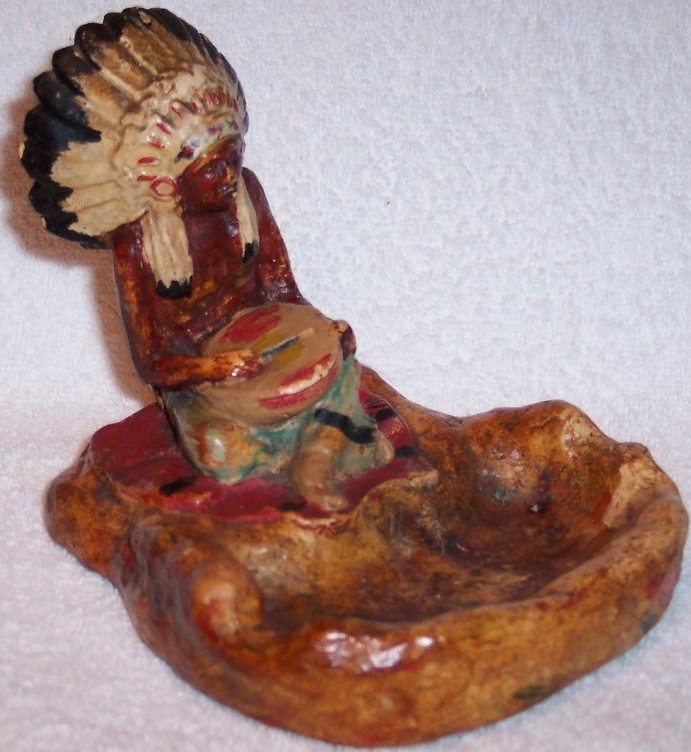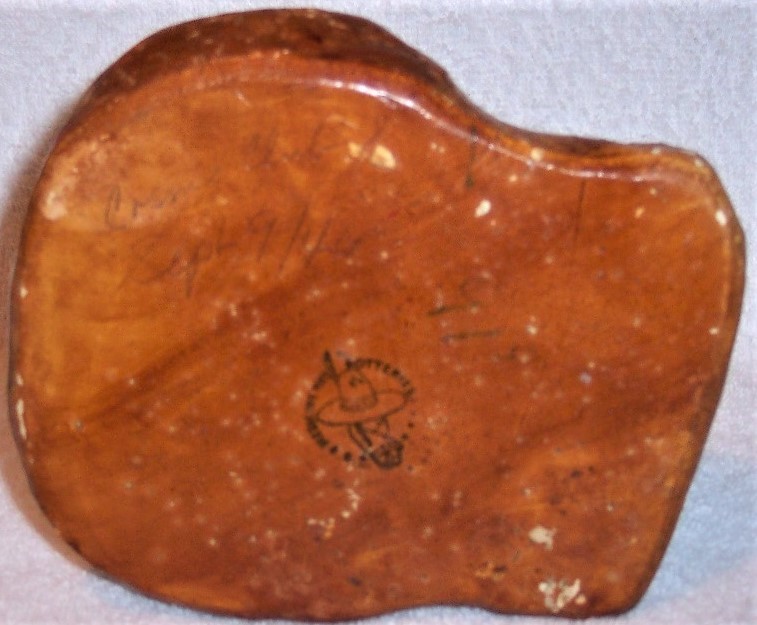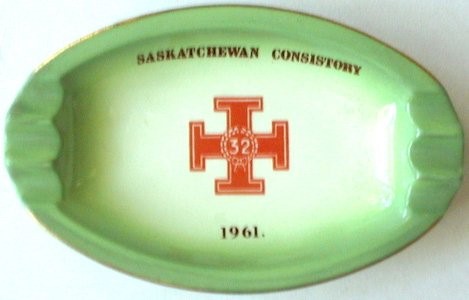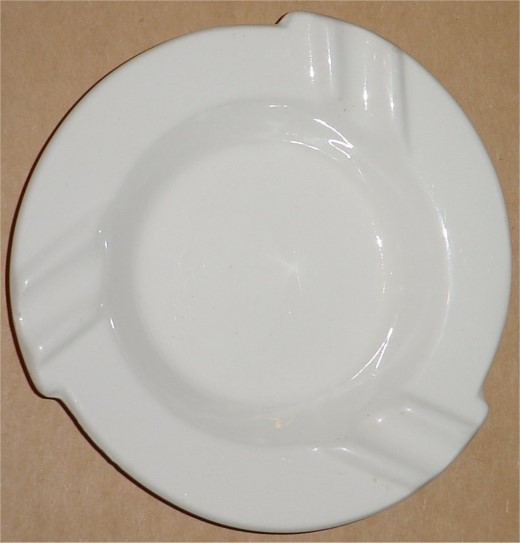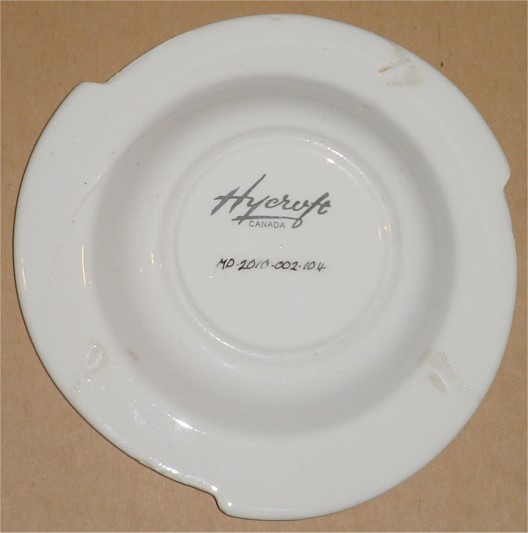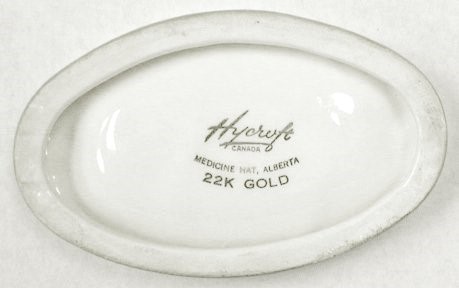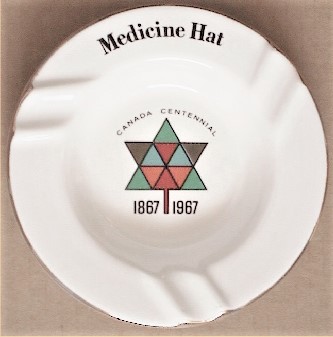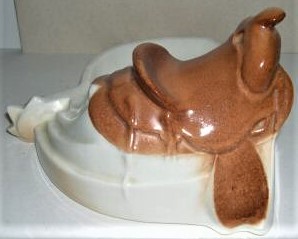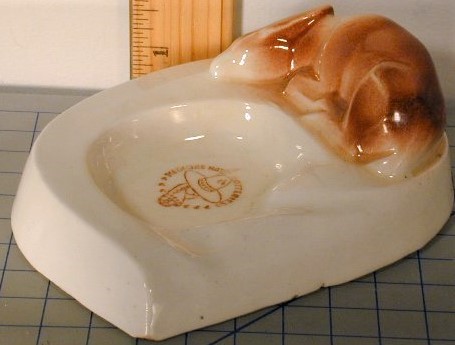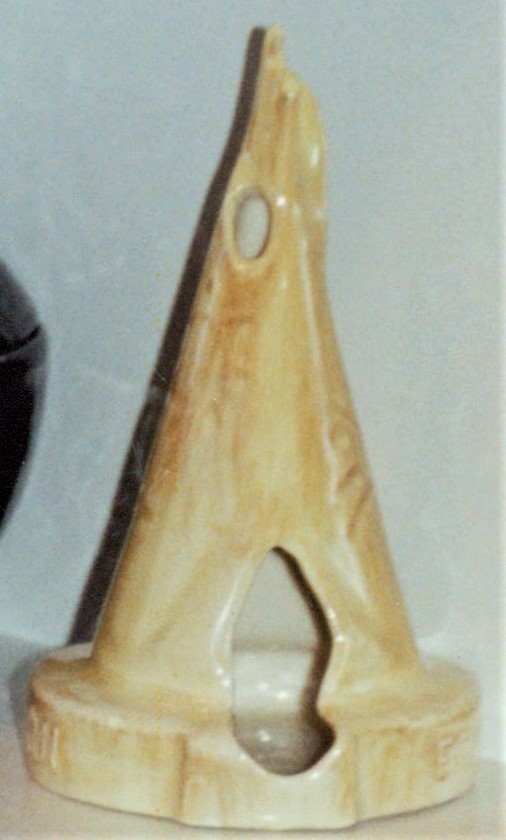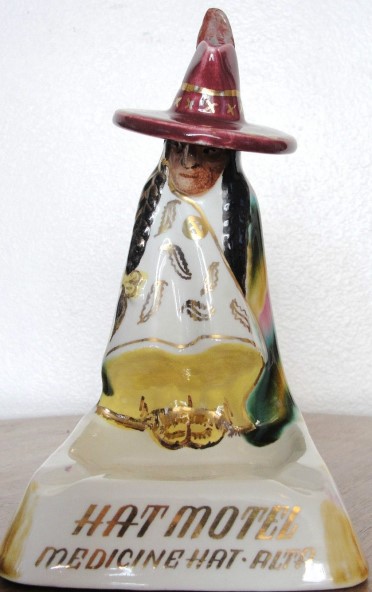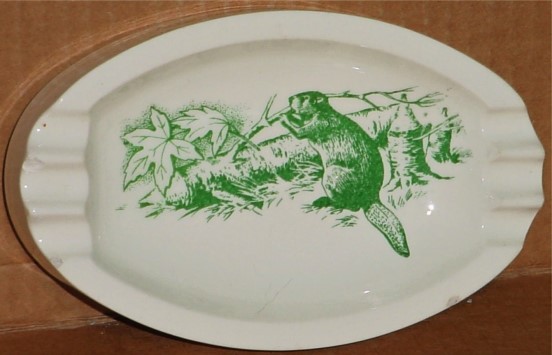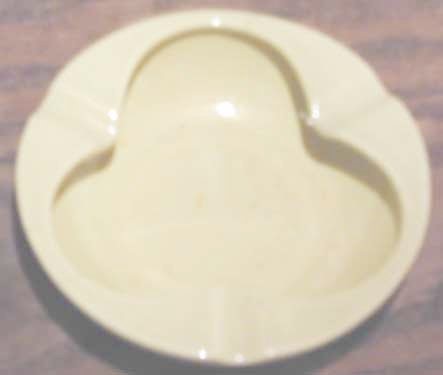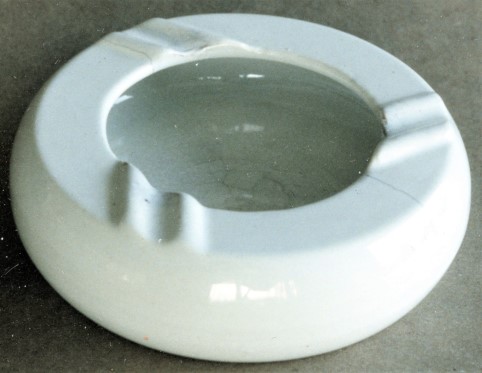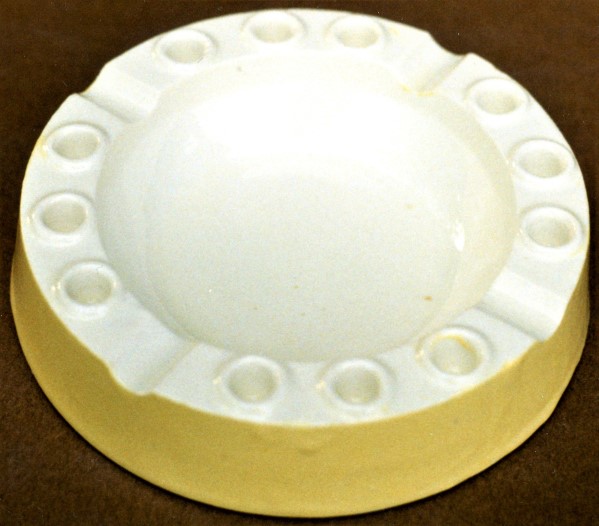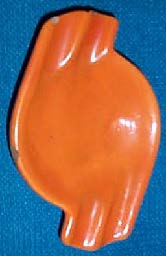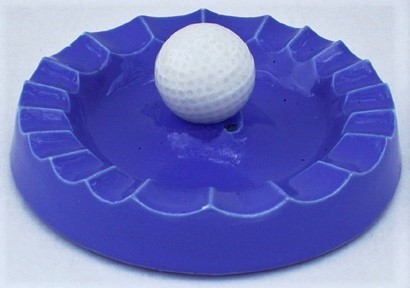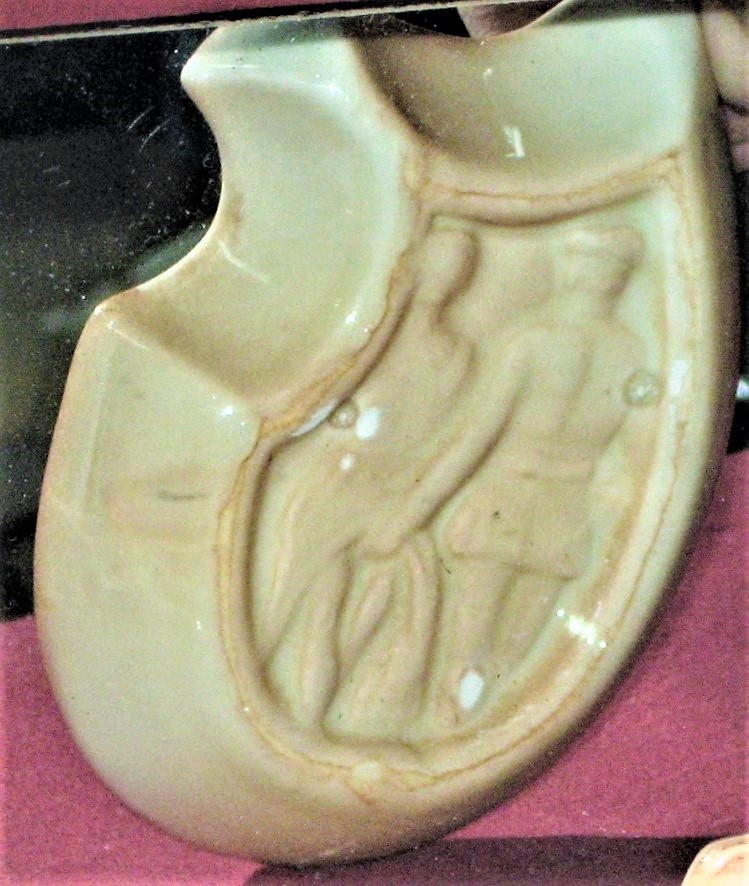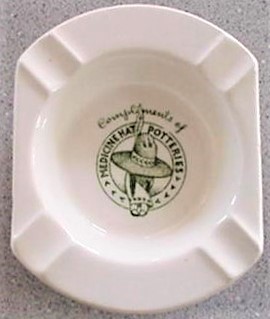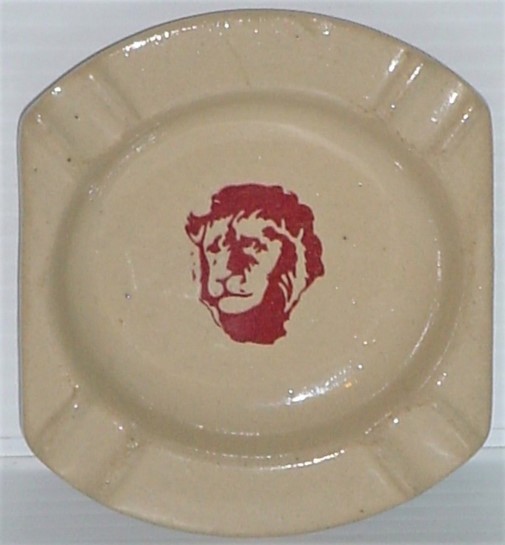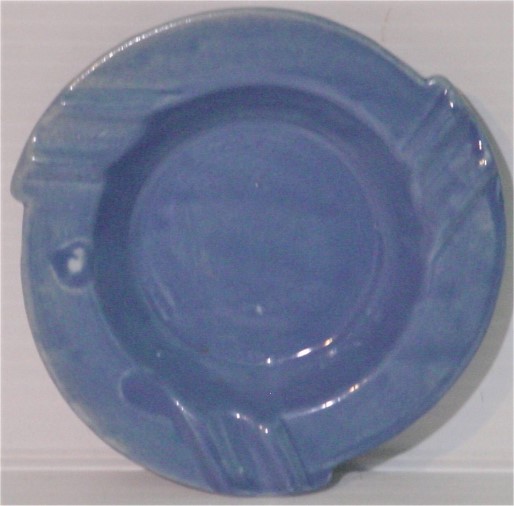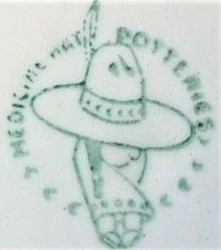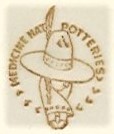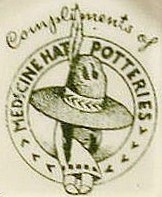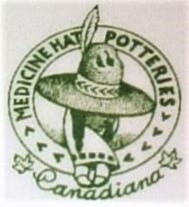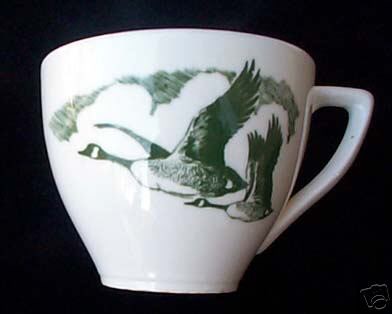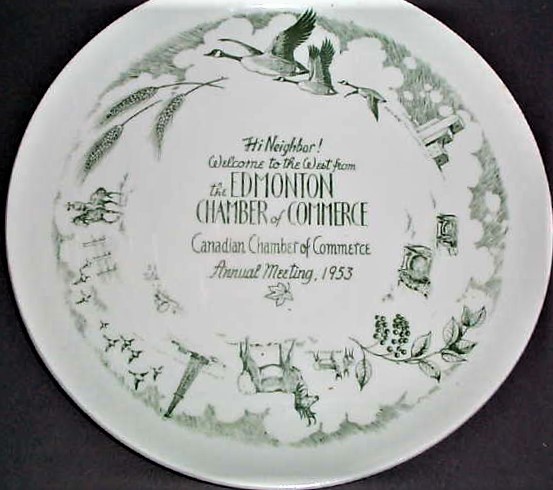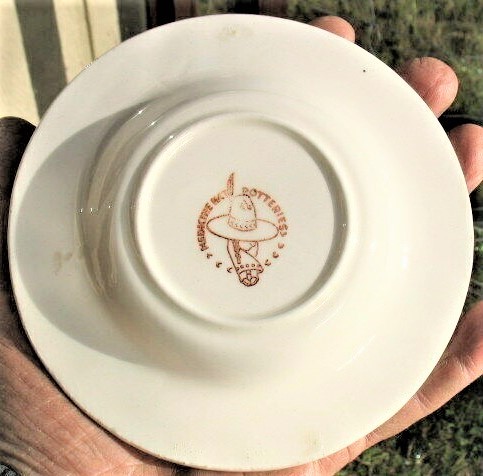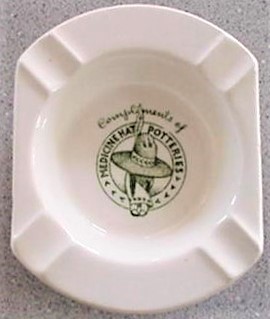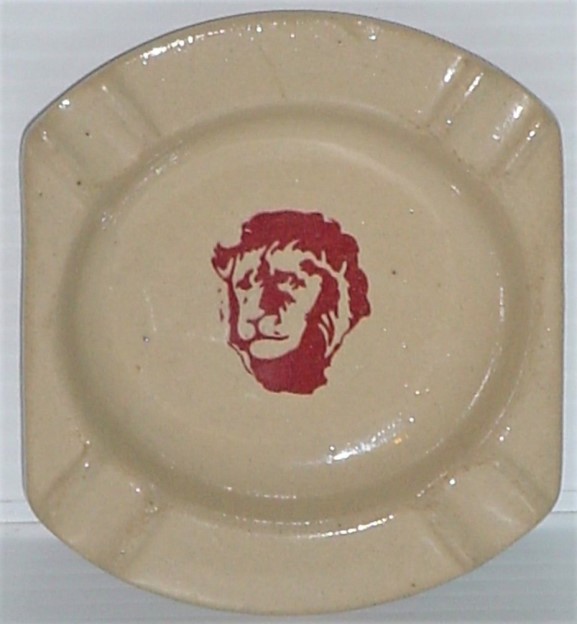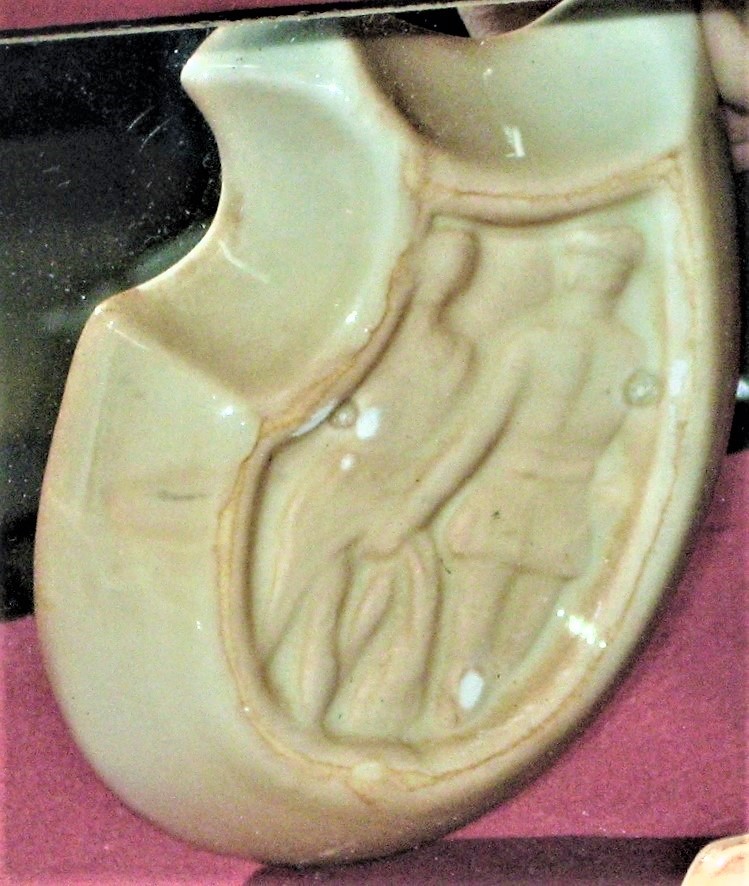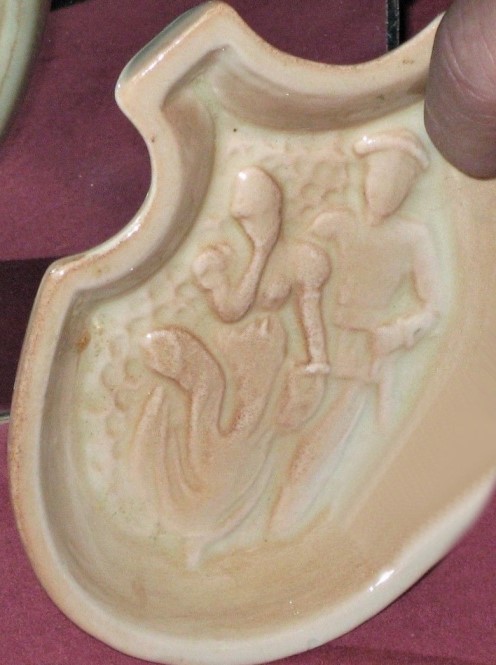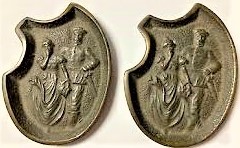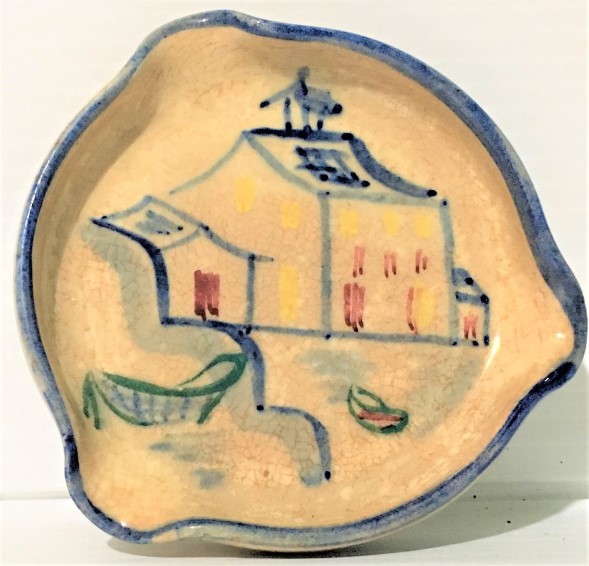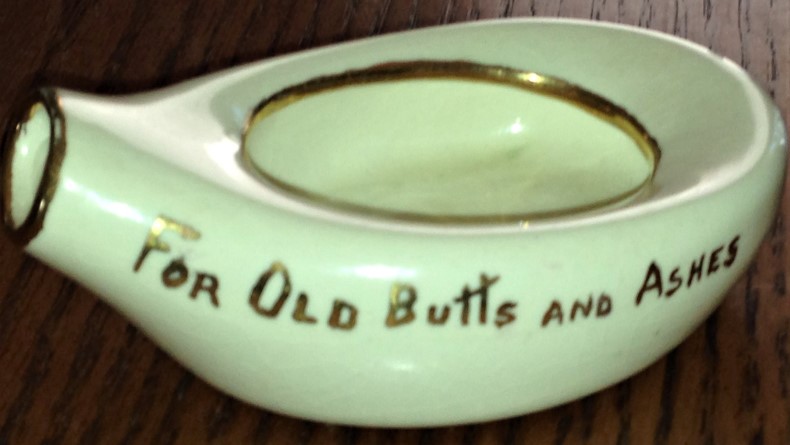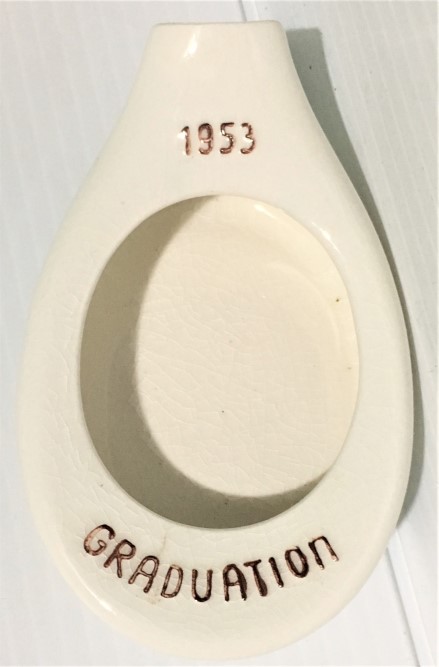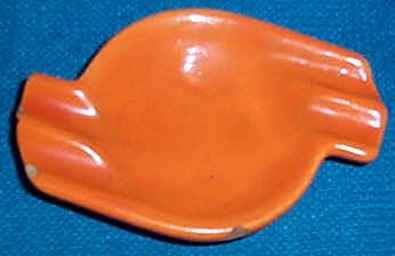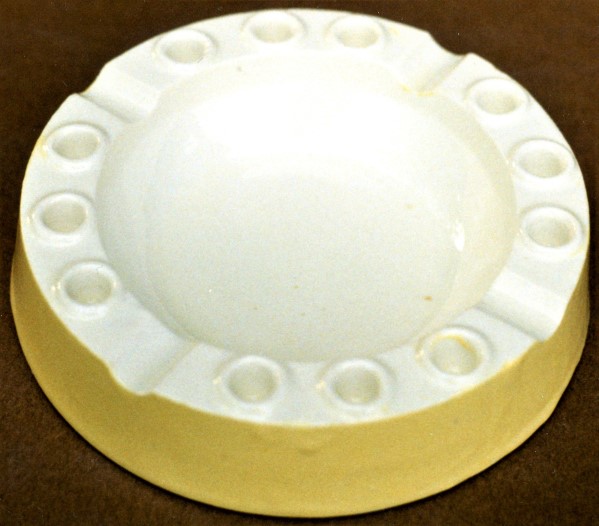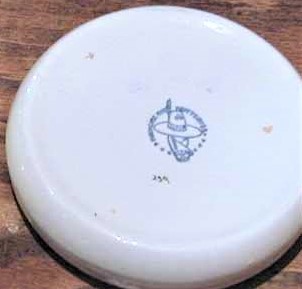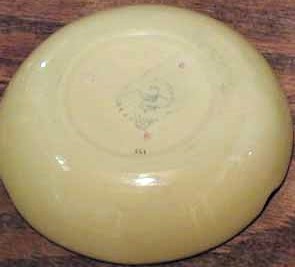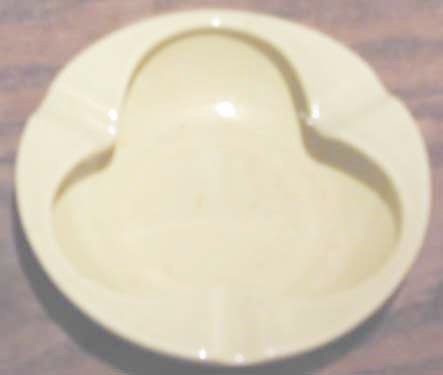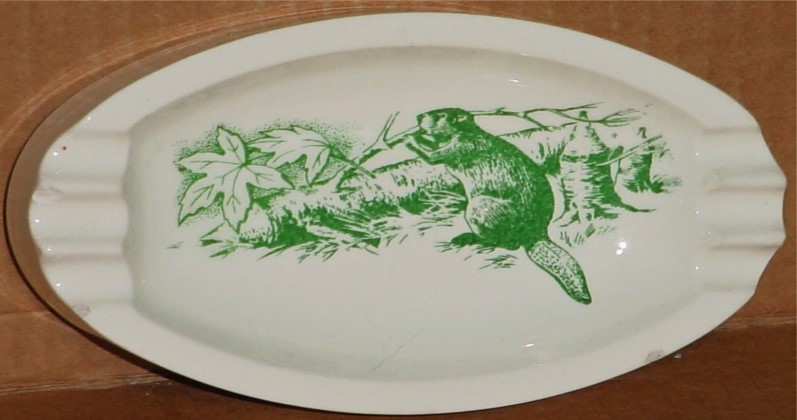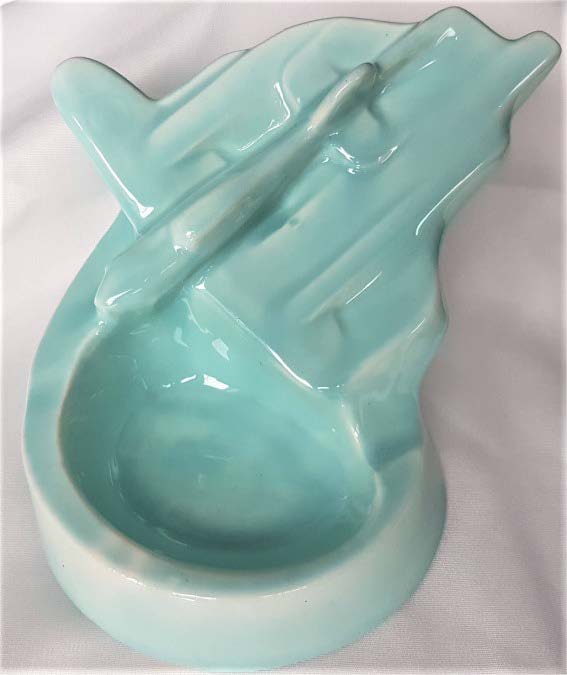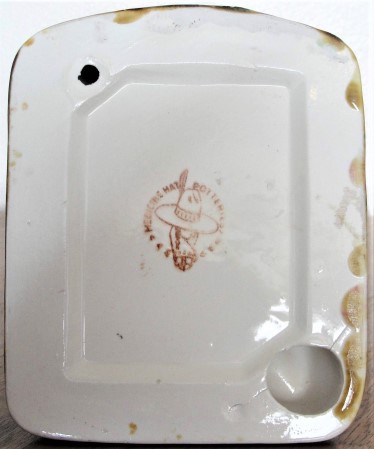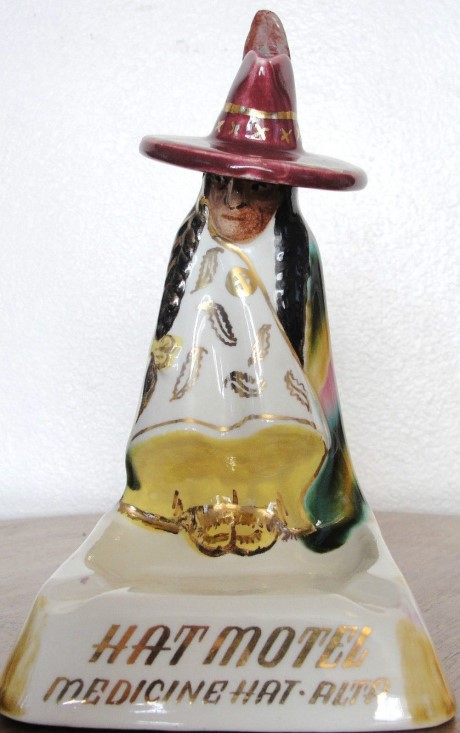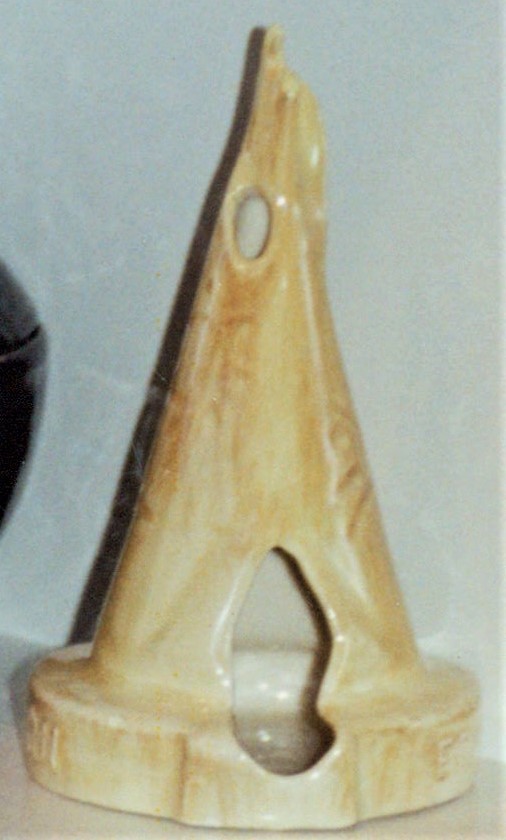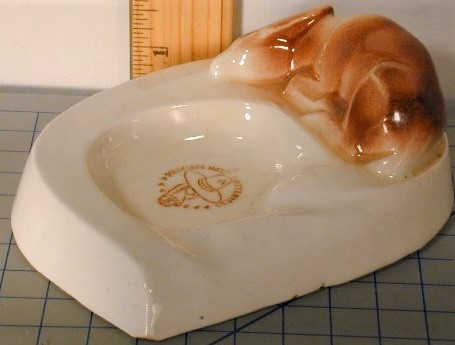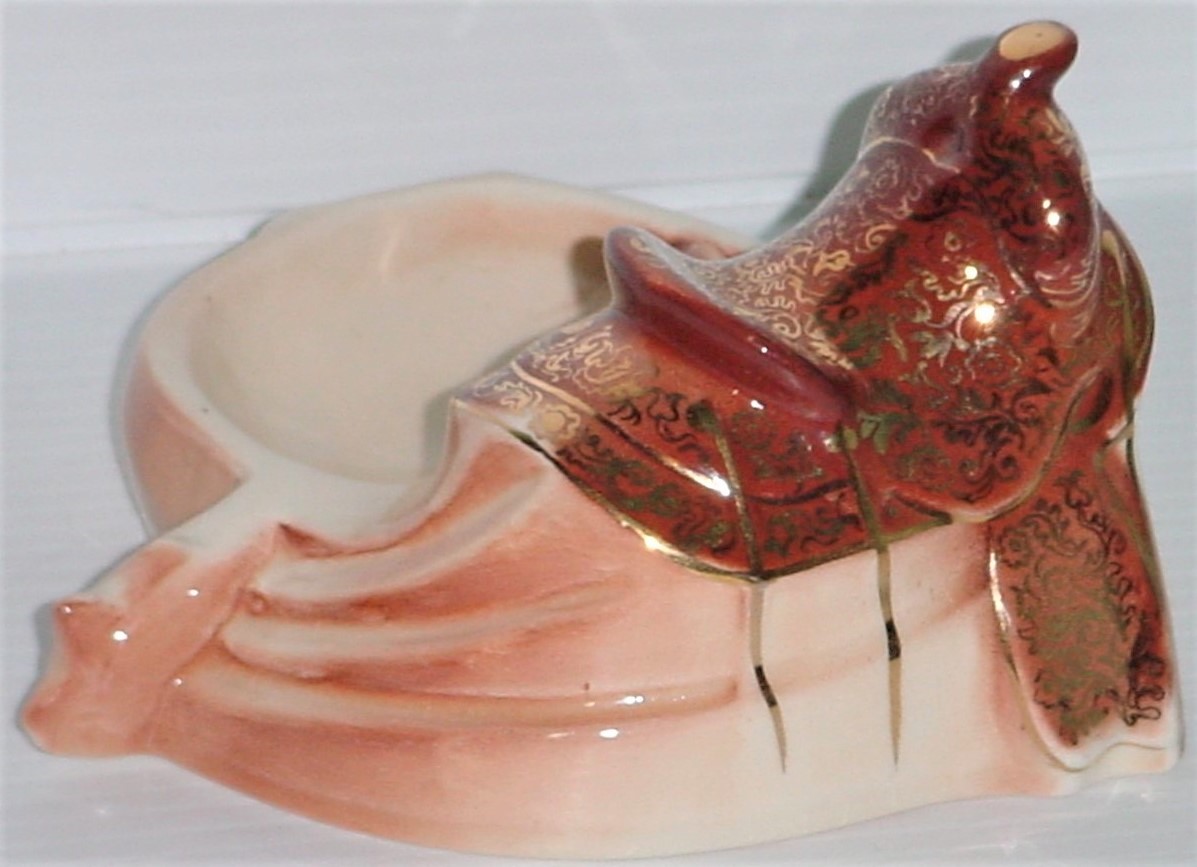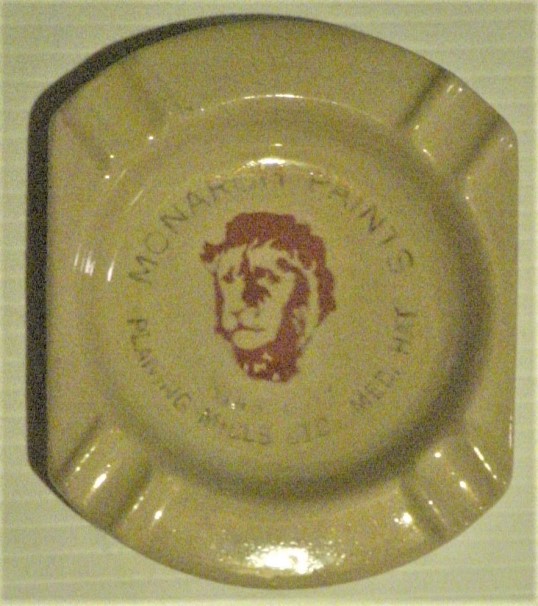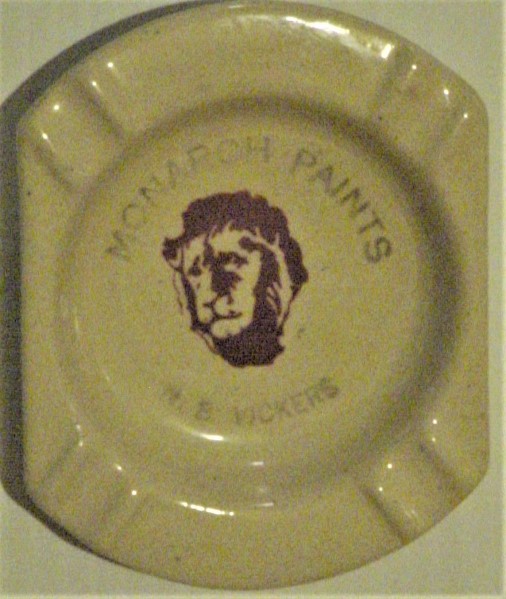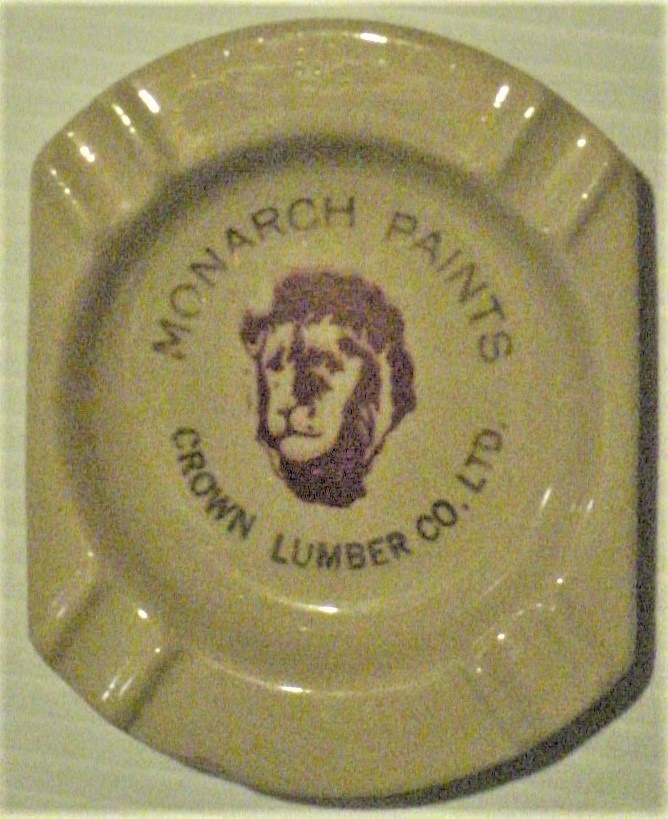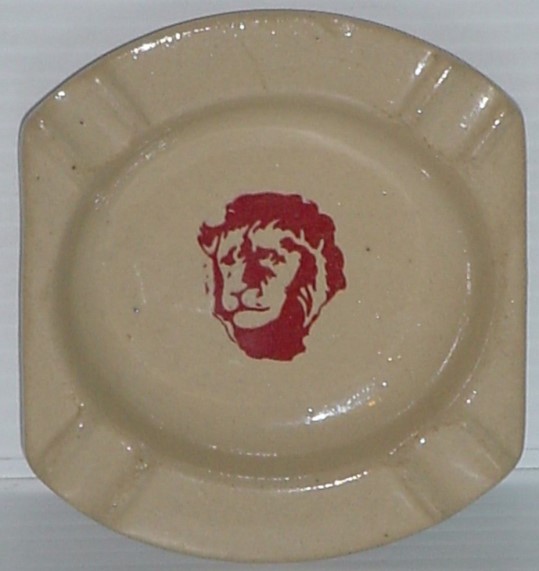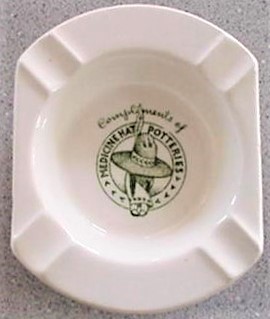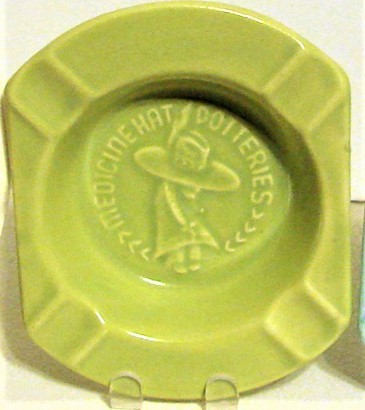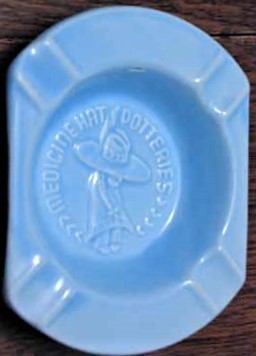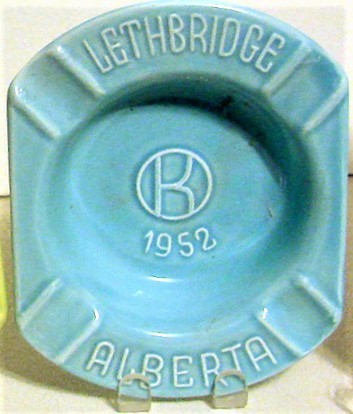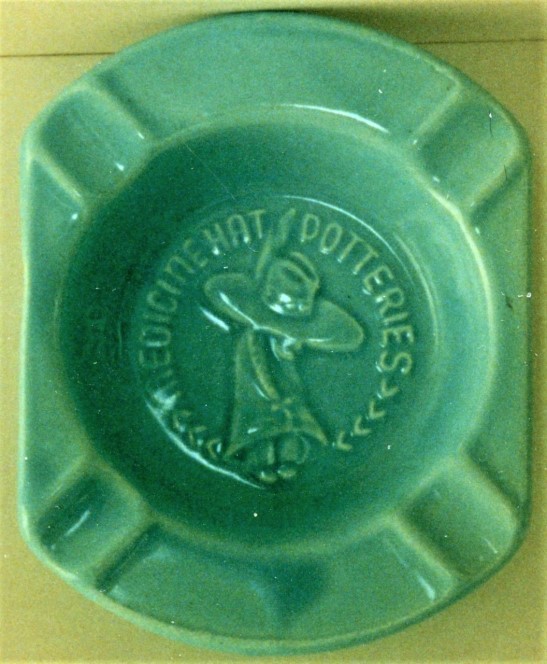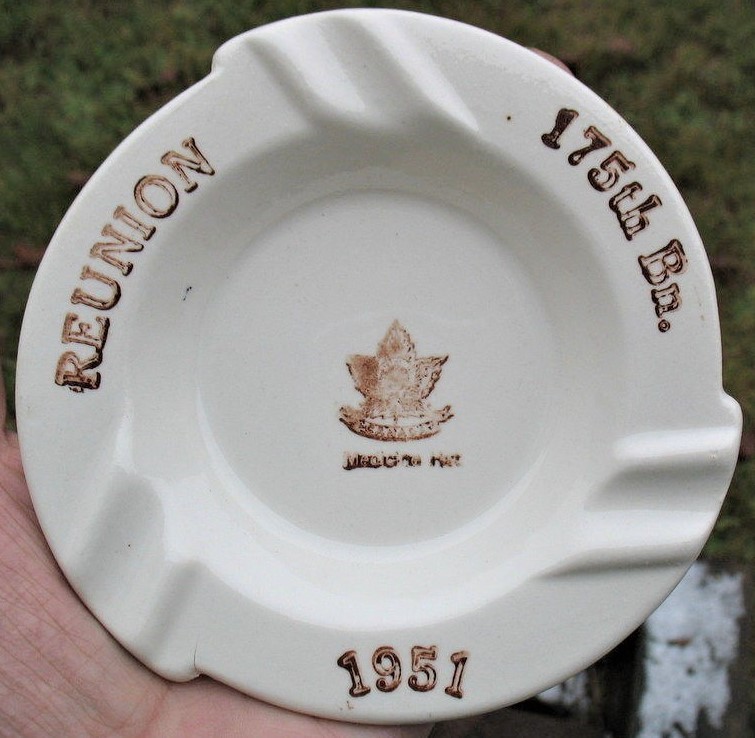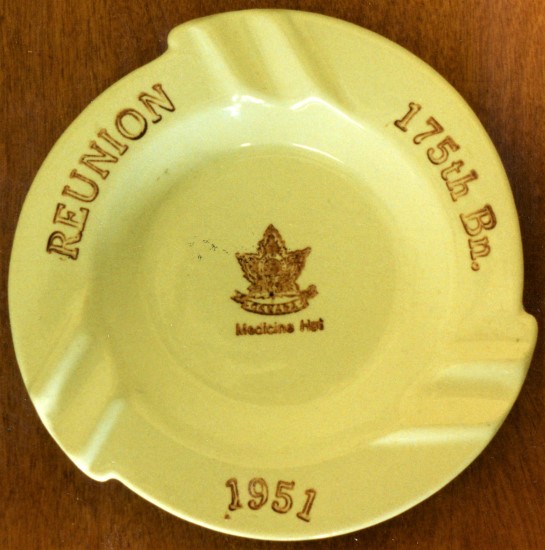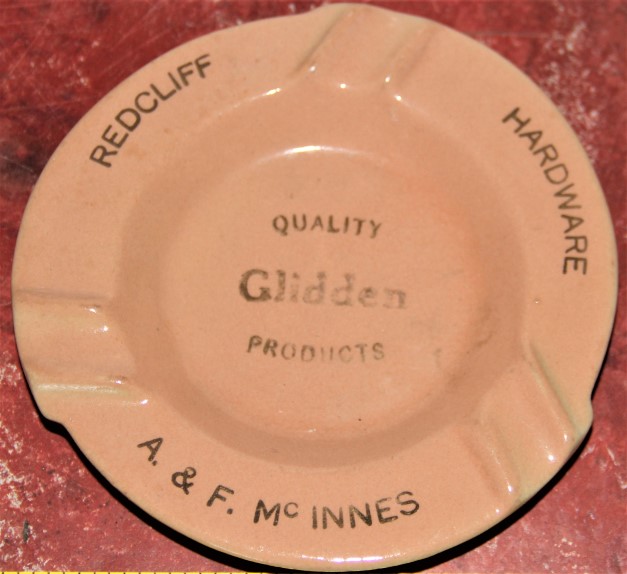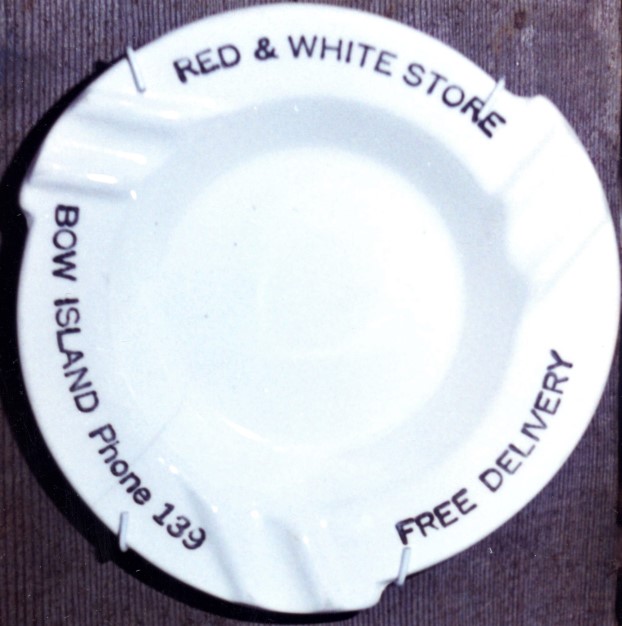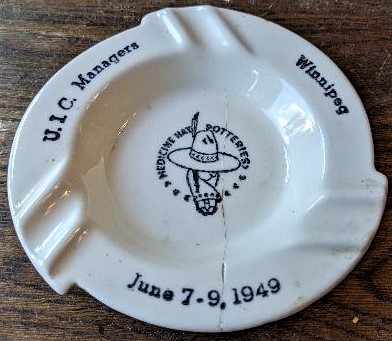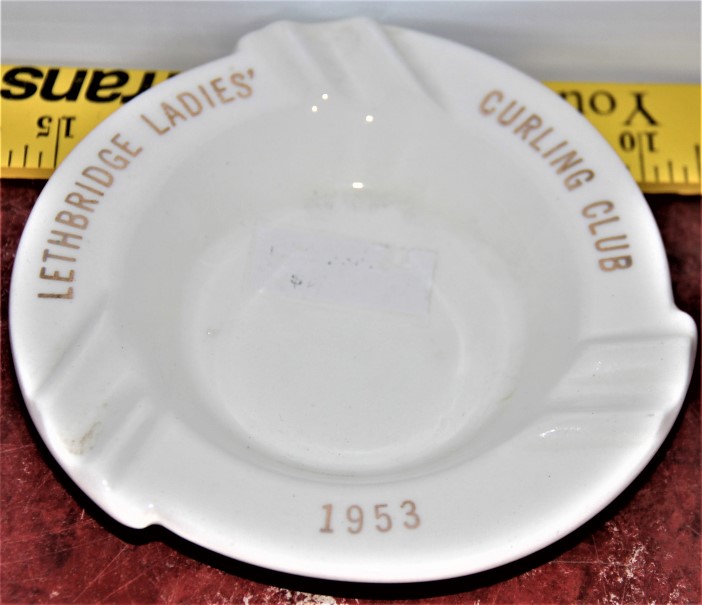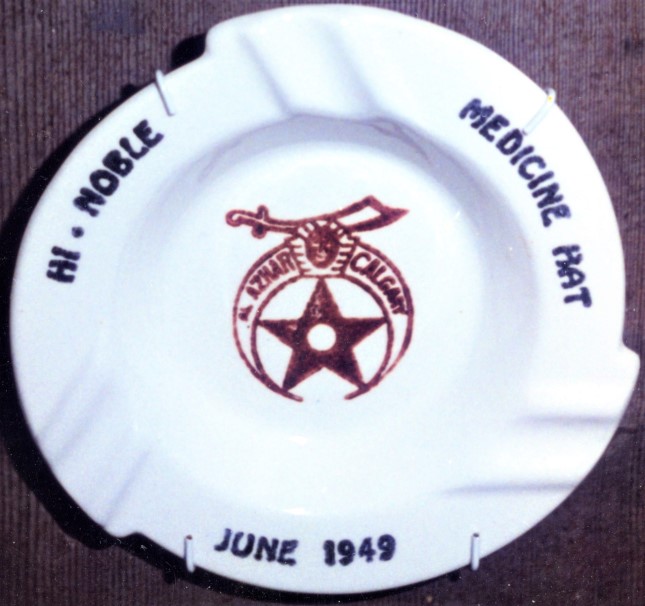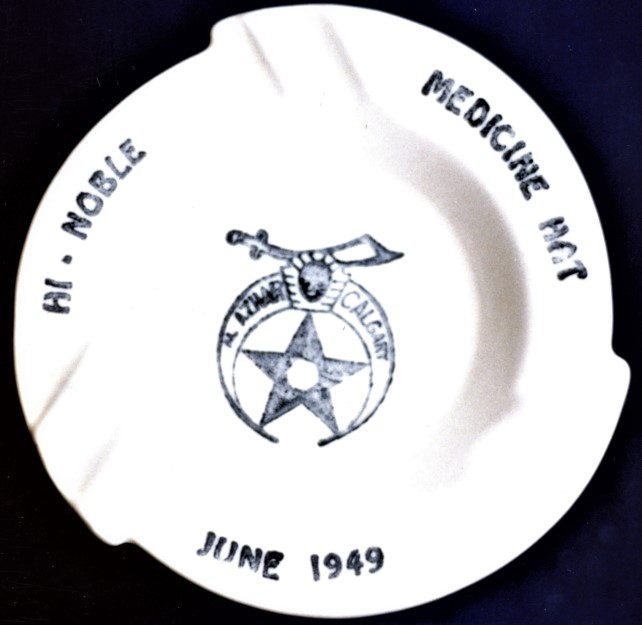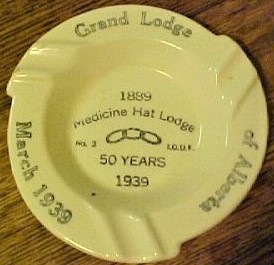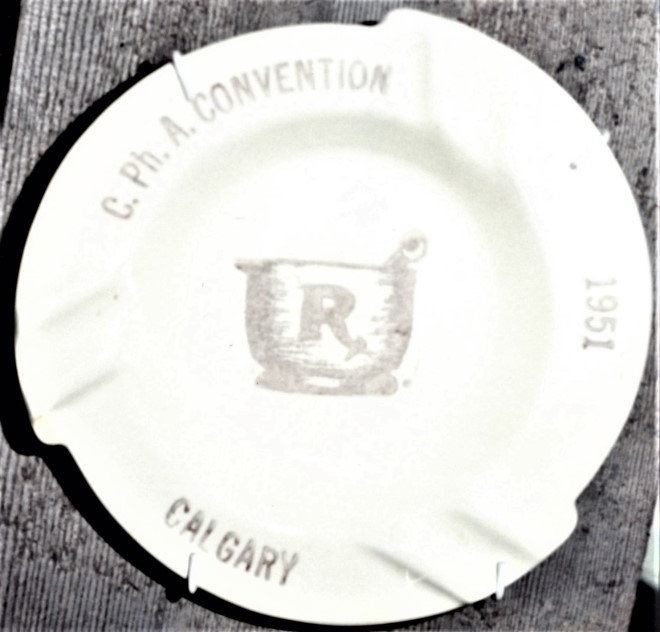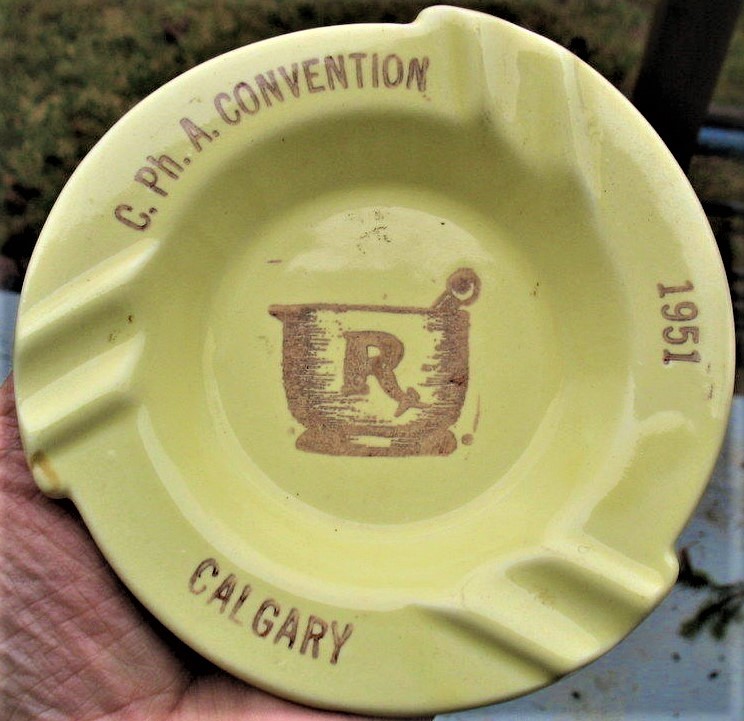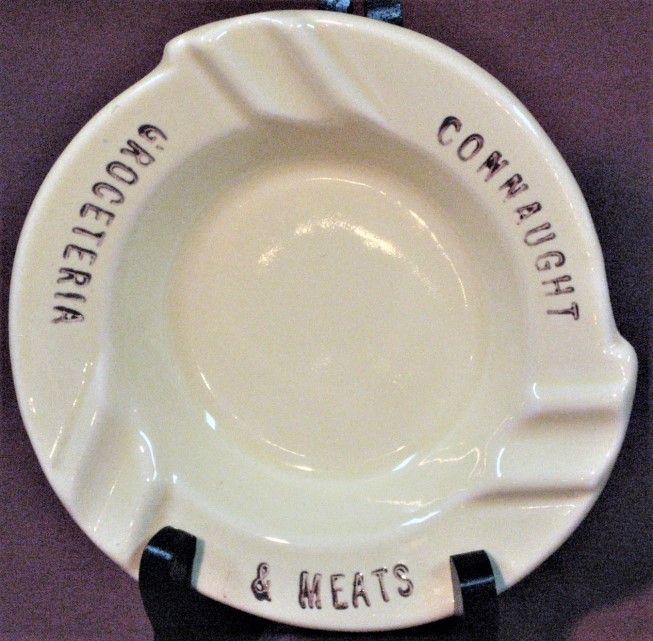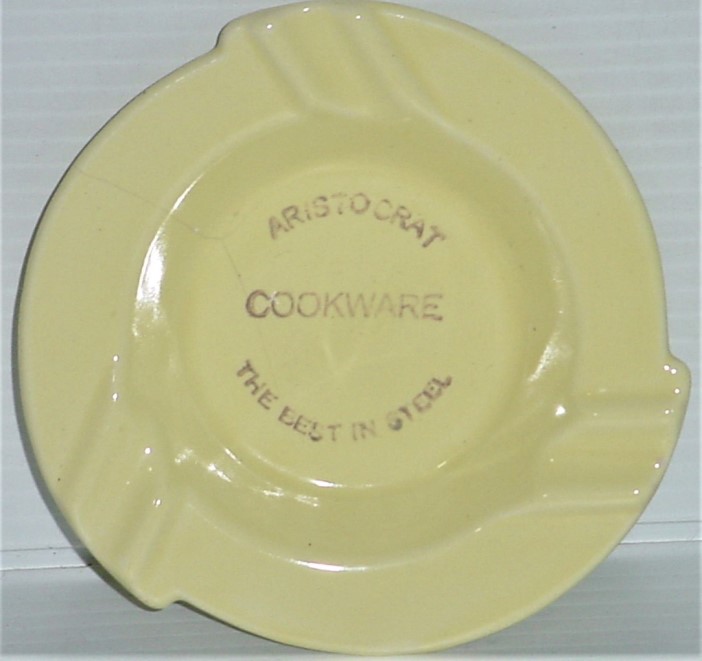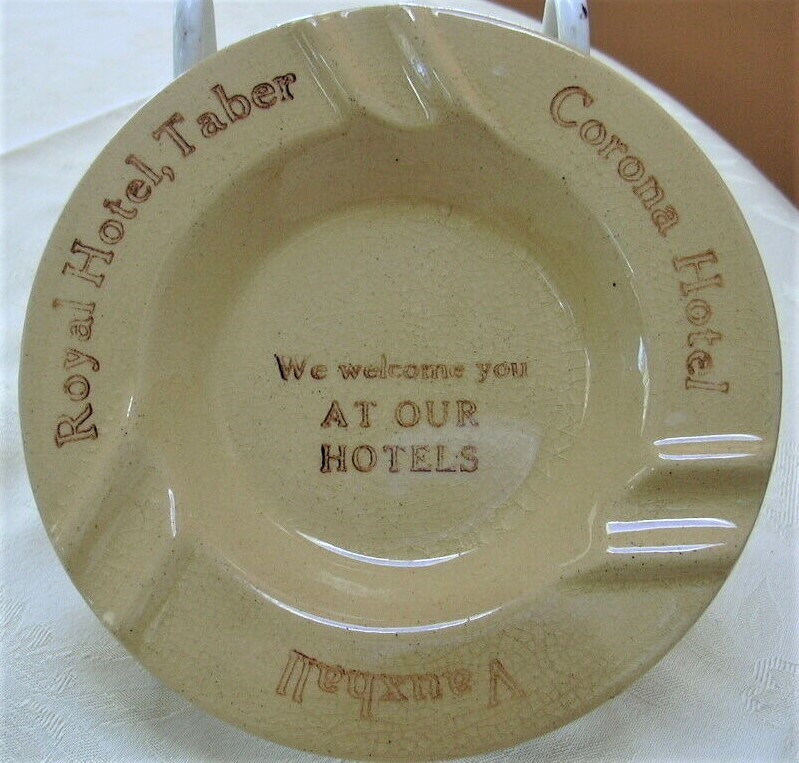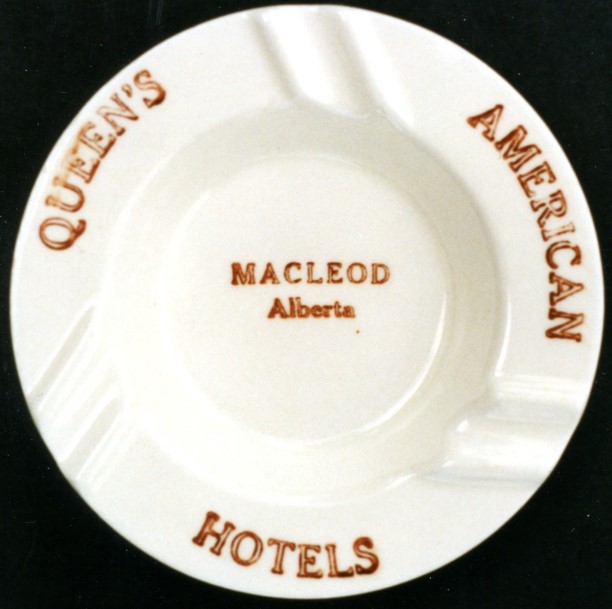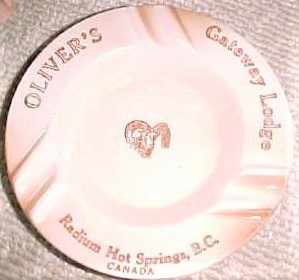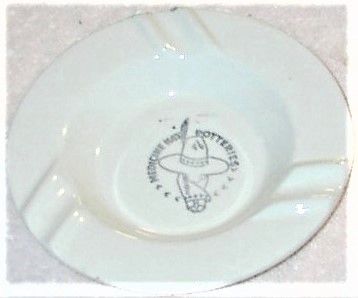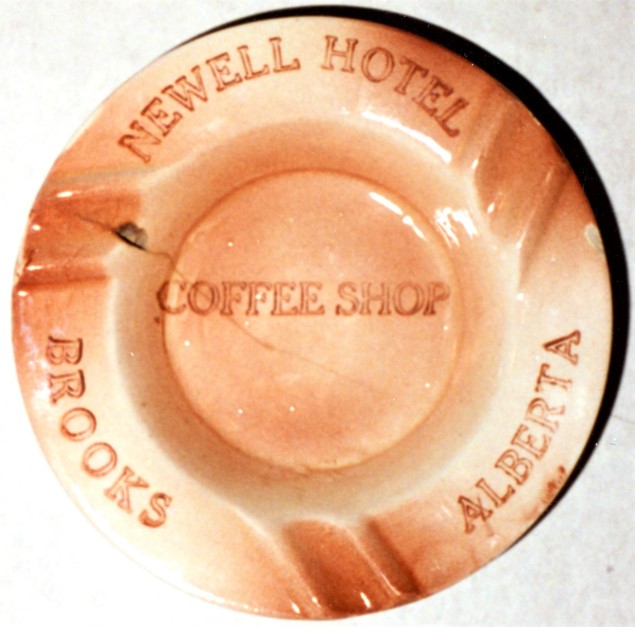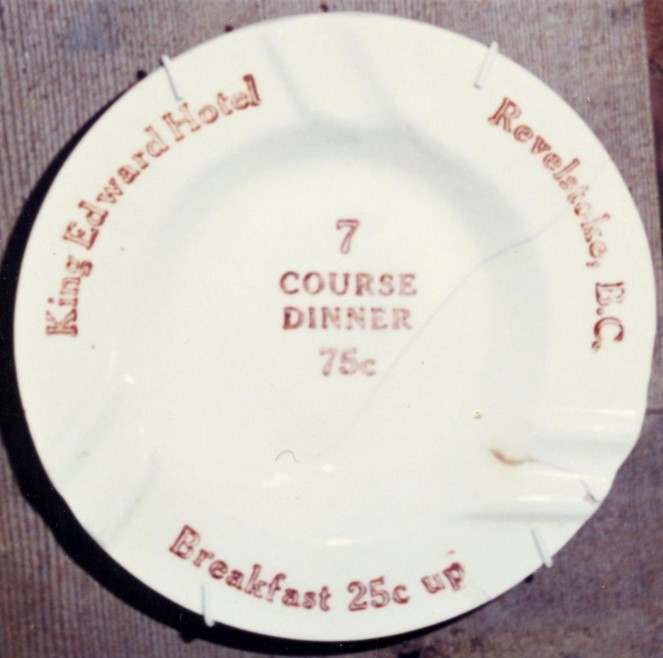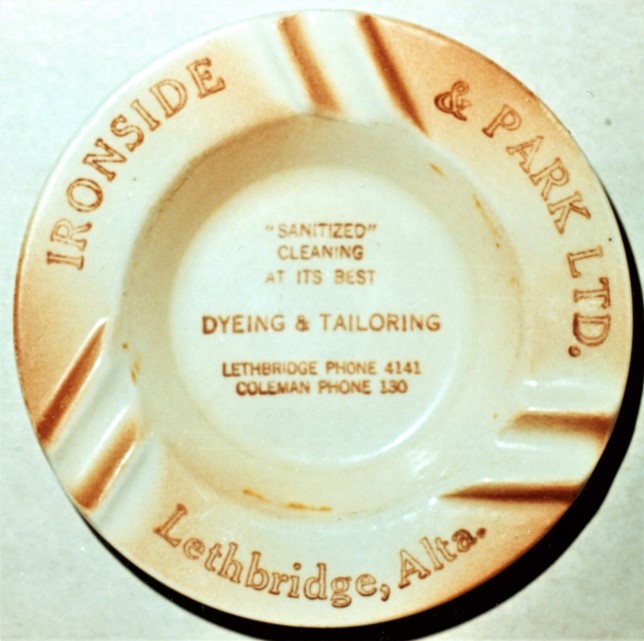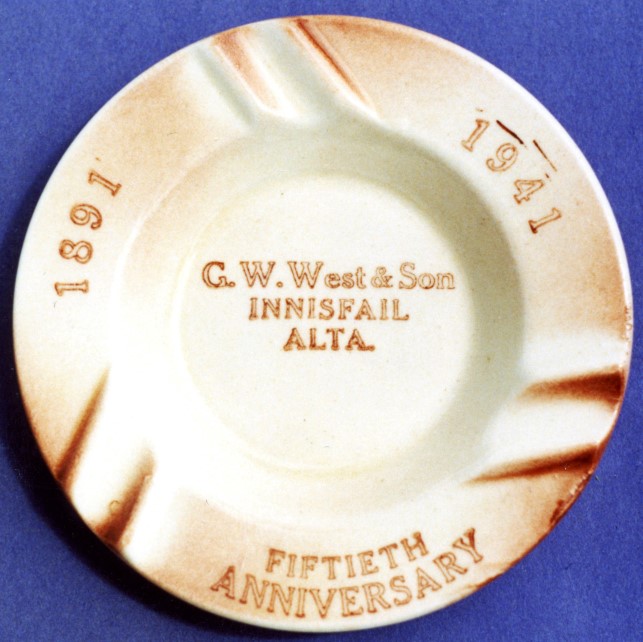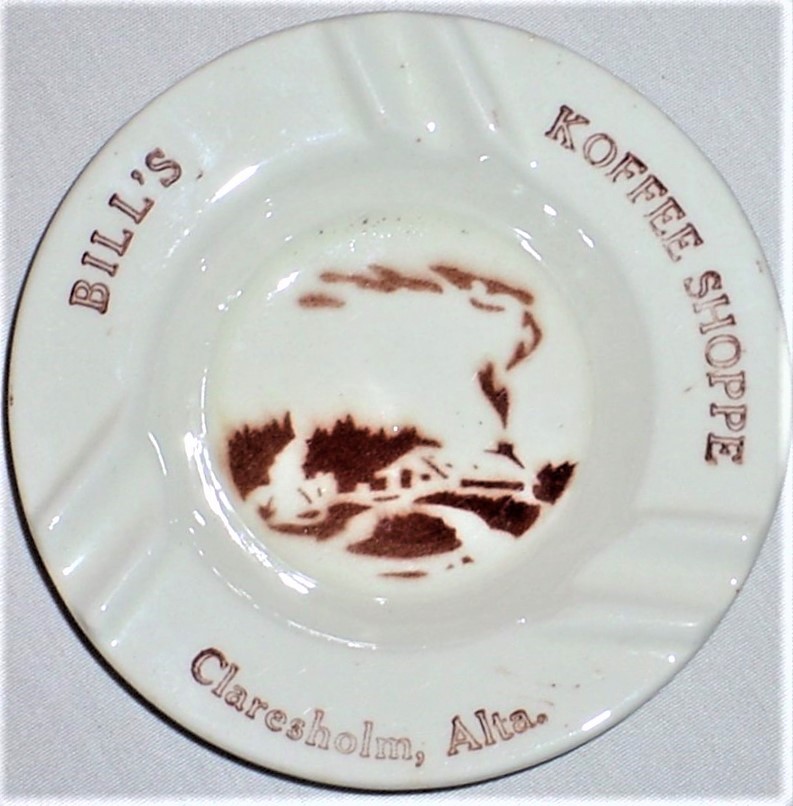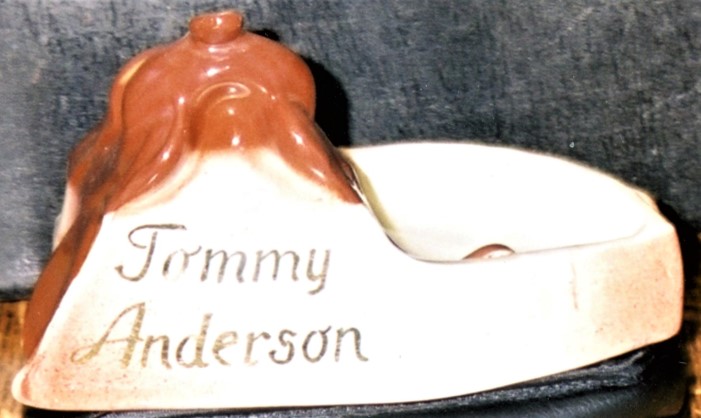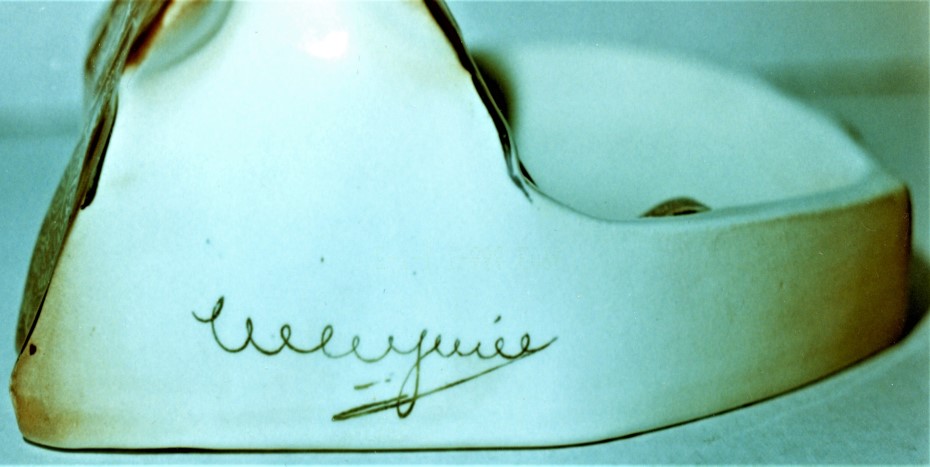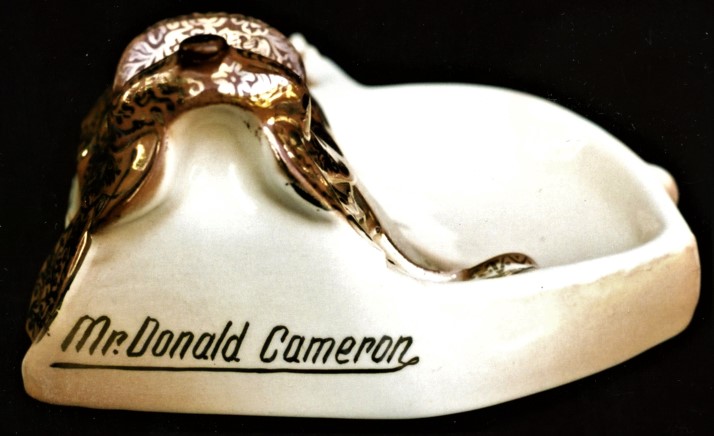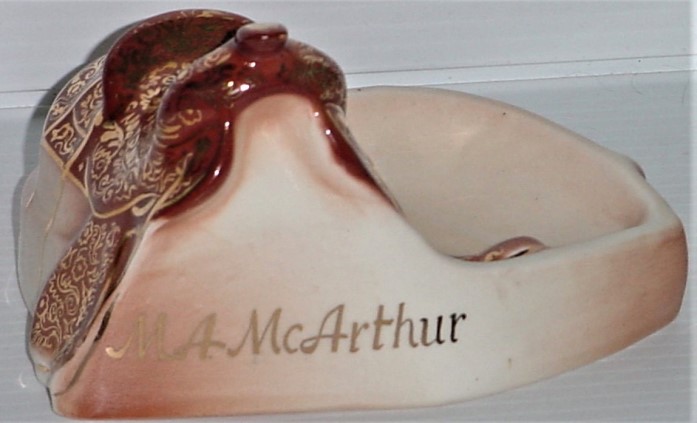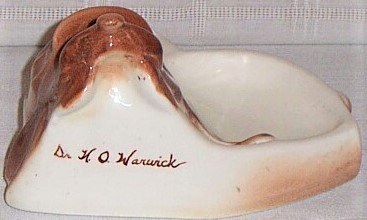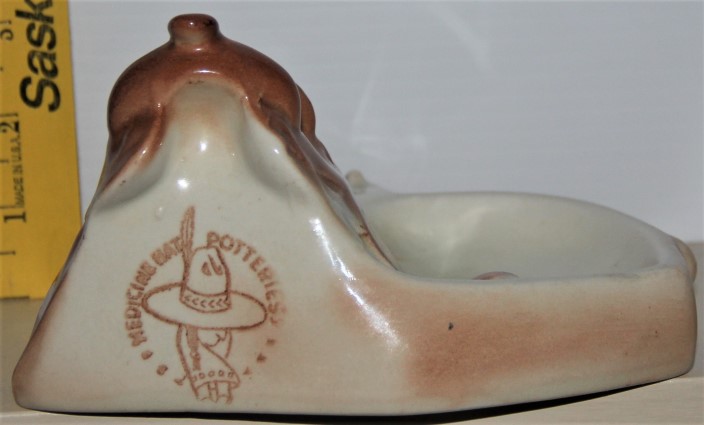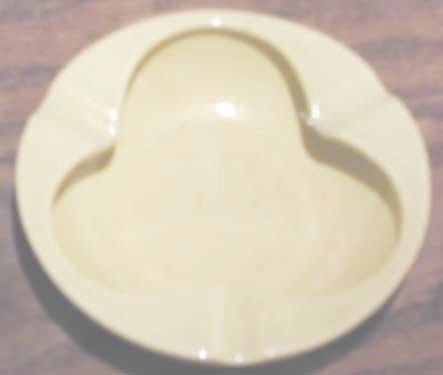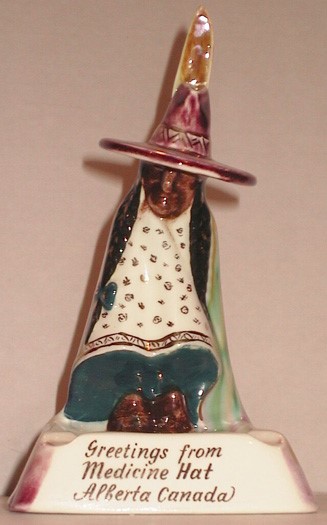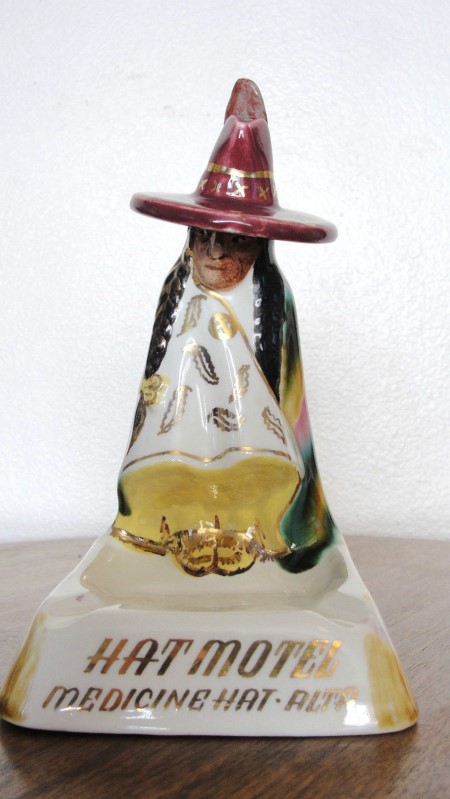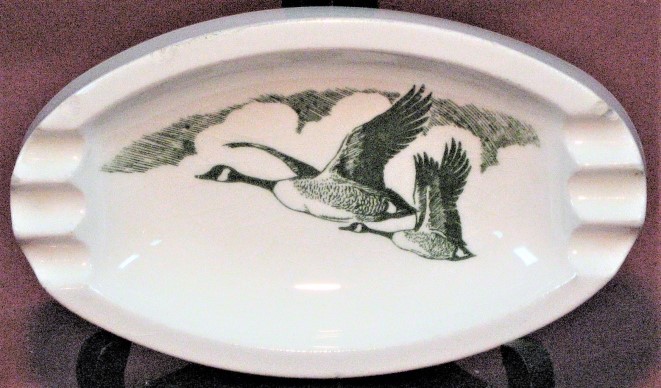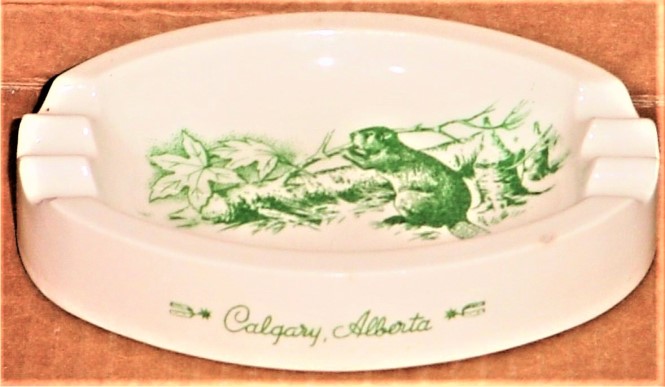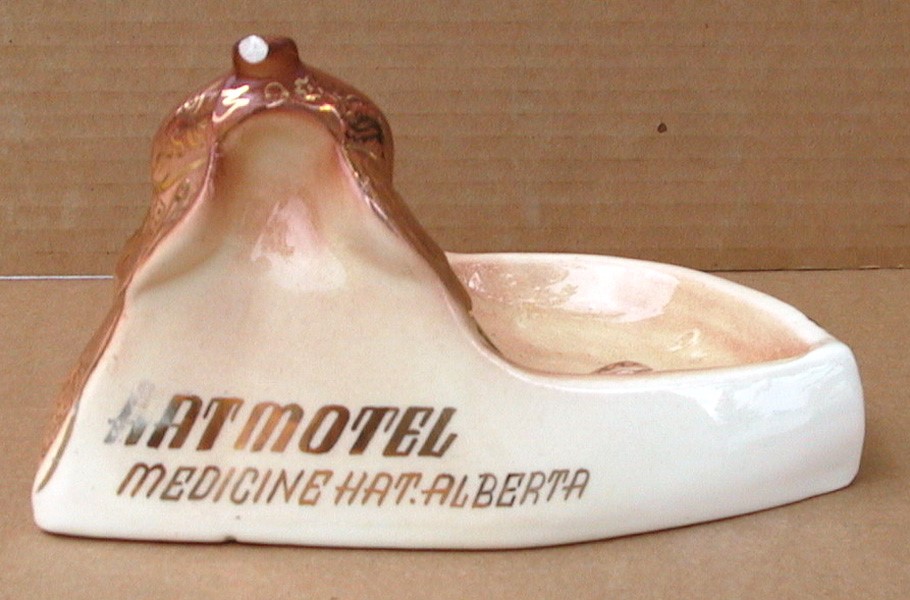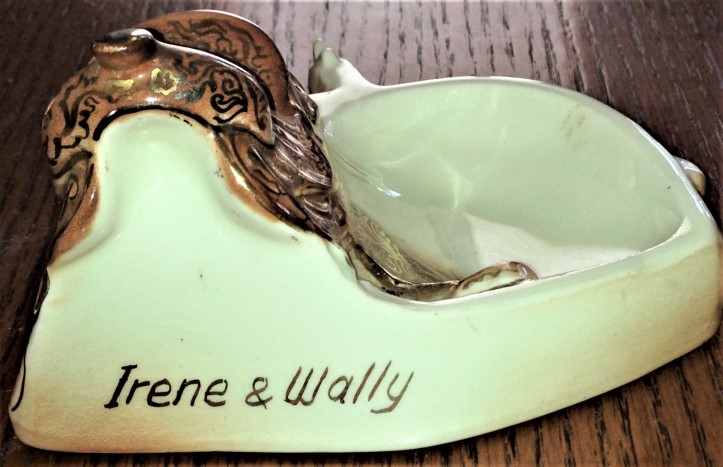Medicine Hat Potteries Ashtrays
Description: The amazing range of Ashtrays made from 1938-1955 by this pottery manufacturer.
The following article will illustrate and discuss the various ashtrays that Medicine Hat Potteries made over the years, namely 1938 to 1955. The plant was built in 1938, and in mid 1955 it was sold to the Marwell company in British Columbia who on the advise of Mac McArthur changed the name to Hycroft China Limited. In this period of time, it appears that MHP designed some 18 ashtrays, but not all necessarily went into full production as so few examples have been recorded. Hopefully this paper will help collectors by showing them what might be found even when they are not marked with a factory stamp.
Some ashtrays marked with the little chief stamp will not be discussed. The first are the products made using plaster rather than fired clay. These are the pieces designed by Jack Fuller. I am only showing you one example as the Jack Fuller story is an article in itself.
The other group of items are the small figural trays made under the Chinook name, possibly used as ashtrays but more likely not, as the Chinook items were a decorative line. As you can see from the picture, the Chinook stamp depicts the little chief below the CHINOOK name.
The last facts I would like to share is that you can find several of the MHP ashtrays that are marked with a Hycroft stamp, readily explainable as Hycroft continued using the MHP moulds along with developing new ones of their own.
The eighteen different shapes.
This article will illustrate and discuss the various shaped ashtrays that the Medicine Hat Potteries company produced over the years. The factory was in busines from 1938 through to 1955 when it was taken over by new owners who changed the name of the plant to Hycroft China Limited. It remained in business under the Hycroft name to 1991, but the plant effectively closed in the mid-1980s only staying open to sell off old stock and to do some specialty orders (usually named commemoratives or advertising pieces).
While Medicine Hat used a few different stamps over the years to mark its products, by far the majority were marked with the “Little Chief” stamp as shown here. The stamp came in different sizes to fit the product on which it was placed as well as a variety of different colours, including black, blue, brown and green in various shades. Ashtrays are usually in brown and black shades.
Two other factory stamps are found on ashtrays that appear to have been introduced around 1950. These stamps are more finished than the ones above as the factory name is within an annulus around the central image. The first is the “Compliments of” stamp that presently has only been recorded on the small ashtray with flat sides and a rounded top and bottom. The second is the Canadiana stamp which is found on items decorated with the Canadiana decals (mainly dishes).
The Different Shapes of Ashtrays
I will let the pictures speak for themselves, and where I can provide additional remarks, I will give them alongside the picture.
This appears to be the favored style of ashtray for advertising premiums. It is quite similar to Medalta’s ashtray, but the butt holders are at an oblique angle. It measures about 5 3/8” dia. x about 7/8” high.
This style of ashtray was also quite popular judging by the number of advertising examples recorded so far. It measures about the same as the previous ashtray from any of the projecting butt holders across to the opposite side. One of the named examples is dated 1939 and another dates as late as 1953. Later pictures will show that many of this style of named ashtrays can be found in different colours.
This ashtray, generally round with the sides cut off, bears a factory stamp that is similar to the Canadiana one and, for that reason, this ashtray probably was introduced around 1950. As you will see later, the general shape was used for a number of different ashtrays with embossed markings in the center. The size is about 4” x 3 1/8” wide.
This ashtray is similar to the one above but it is larger, measuring 4 1/2” x 3 1/2”. It is also made from a different clay than the one above. So far all recorded examples have had the lion-head decoration in the center, but the only one with a factory stamp on the back was the one named to N.B. Vickers
This double sided ashtray is rather saucy or risqué. I have seen several of them, but none were marked with a factory stamp. It measures 1” thick x 5 3/8” high x 4 1/8” wide. The reason I believe it was made by MHP potteries is because it was in the personal collection of Malcolm McArthur who worked at the pottery. Also it is finished in the same brown tone glaze as found on many of the MHP ashtrays. McArthur undoubtedly copied it after the brass example also shown here.
This roundish ashtray with three pushed-out butt holders is the only example of this shape that I have recorded. It is about 7/8” high x 4 1/2” wide from the butt holder to the opposite side.
The miniature chamber pot was given to the 1953 graduating nurses at the Medicine Hat General Hospital. In all likelihood it was intended to be used as an ashtray. The other example shown here was acquired from a person who worked at MHP and clearly it was Intended to be used as an ashtray, but it did not have a factory stamp on it.
This small ashtray has not been matched with any ashtray listed in the MHP Shape Book, but it surely had to be available by 1940, or very soon thereafter, as its colours match those of the Hatina Ware dishes. A boxed set of these small ashtrays included 4 different colours, namely yellow, navy, white and orange. The ashtray is 7/8” high, the rounded central part is 2 3/4” in dia. and the overall length is 4 1/8” .
The golf ball ashtray is not listed in the shapes available by 1940, so I have no way of knowing when it was introduced as a new product. One example, though, was inscribed in the bottom with the owner’s name, or perhaps the maker’s name, stating “W Lunts / MED. HAT. ALTA. / 1949”. It is 2 3/8 max. height x 16 1/4 dia.
The cigarette-holder ashtray, like the one above, was not available in 1940 and in all likelihood it came into production after WWII. It measures about 1 1/2” high x 6 1/8” dia. So far, this is the only example that I have recorded.
This ashtray is likely the one that the MHP Shape Book lists as C-50, the Bridge ashtray. This white glazed specimen is the only one for which I have photo- graphs. Presently, its measurements are not known, but it is about the same size as the Shamrock one below.
This ashtray has to be the one that the MHP Shape Book lists as C-51, the Shamrock ashtray. I have recorded it in yellow and orange, and it measures 1 1/4” high x 5 1/8” in diameter.
The oval ashtray was likely introduced about 1950 as suggested by the Canadiana scenes regularly used to decorate it. It measures about 1” high x 3 3/4” x 6” long.
The airplane, figurine ashtray has only been recorded by me in the turquoise blue glaze. I do not have specific measurements on it as I have not had anything but photographs pass through my hands. It likely was introduced after WWII. It seems to be one of the pieces especially sought after by collectors of MHP and, perhaps, it has a much broader appeal than that.
The Little Chief, figurine ashtray is quite unusual, but I have only seen two specimens sold on ebay, one being the one shown here. It measures about 7 1/2” high with the base being 4 3/8” x 5 1/2“. Someone got a good buy at $84.00 US, but I did not make a note of the date sold. All the other examples shown here were from the personal collection of Mac McArthur.
The tipi shaped ashtray. This ashtray was also in the Mac McArthur collection and, due to its light brown on cream colouration and similarity to the Little Chief ashtray, it is surely made by MHP even though it has no factory stamp on it. The cigarette would rest in the tipi entrance, and the cigarette smoke would escape through the hole near the top. The base on which the tipi sits is about 3 5/8” in diameter and the total height is 5 3/4 inches.
What you cannot see in this photo is that on the left side of the 3/4” high base is embossed “C.F.R.N. and embossed on the right side is “EDMONTON”. Surely more than one was made!
I have never seen an ashtray shaped like this for sale anywhere.
This figurine ashtray is the one listed in MHP Shape Book as style no. C-64, and all recorded examples have C-64 impressed in the bottom. Also all examples I have seen have the “Little Chief” stamp in the bottom of the ash holder area. It measures 1 7/8” high and is 5 1/4” x 4 1/8” across the bottom.
The saddle and spur ashtray is not mentioned in the MHP Shape Book and, thus, it was likely introduced after WWII. It can be found with a plain saddle or with one decorated with gold scroll work simulating highly-tooled leather. The only dated one was made for the Lion’s Club of Medicine Hat in 1950. This ashtray can be found with business, club and personal naming, but personally named ones are seen most often. It measures 3 3/4 “ high and is about 6 3/4” max. width across the bottom.
The named items that I have recorded for which I have no pictures include:
Mr. Chas. Pudwell
E. Spitzer
MEDICINE HAT / Alta.
All Pictures That I Recorded
The range of colours recorded include: yellow, navy; white, orange (as in the boxed set), a medium blue and the turquoise and marble-like ones as shown here.
This picture was sent to me asking if I could confirm the name as Willie Yuill. I could not confirm that W.C. (Bill) Yuill used that nickname.
Copyright rongetty.com, All Rights Reserved
Login - 216.73.216.6
